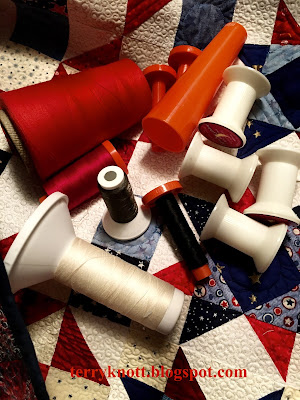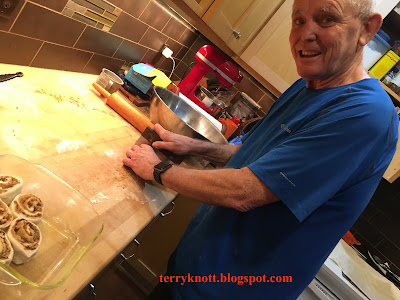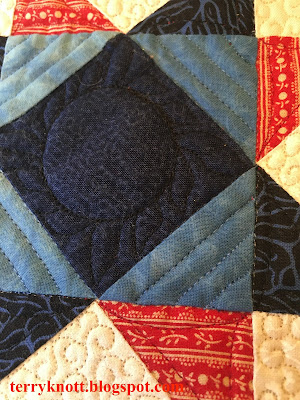 |
Grayscale of the fabrics
|
This quarter our Thread Tales book club read "The Nightingale" by Kristin Hannah. I had read this book a couple of years ago; but, I reread it. Rarely, do I read a book a second time! After I finished the book the second time, I had my inspiration. . .footsteps. One of the characters rescued 19 Jewish children, while having a German officer billeted in her French home.
She raised her best friend's boy Ari as her own after the Germans physically removed her friend from the community. Since I had the inspiration, I thought that the project would materialize quickly. Was I ever mistaken! The first month flew by. Mid way through the second month, I had a conversation with a friend about what I wanted to do. The brainstorming session helped; but, I still didn't have either a sketch and/or plan for the project.
 |
| Pieced background |
I sketched a heart with footprints walking through the heart. I sketched a teddy bear. I sketched 19 pairs of footprints. I really wanted to use the foot/shoe print I had taken when our youngest granddaughter was about a year old. I liked the tread of the shoe. The tread was a narrow zig zag. I thought about hand embroidery stitches for the tread. I thought about painting the shoe prints on a piece of fabric. I thought about brown, tan and cream backgrounds. I thought about using a fabric printed with French words as the shoe print. I made no actual progress because no thought "jelled."
This is the month we reveal our projects. Tuesday is our virtual reveal. I have struggled with having a project to share. Two weeks ago, I looked again at that fabric printed with the French words. Although I've been using an application on my phone to learn French, I can't translate what it says. The fabric is printed with parts of a letter because I can read the months of March and July! I can also read parts of an address. I decided the words would represent the tread of the shoe.
 |
| French print fabric |
I made a copy of the outline of the shoe print. I placed the copy on the fabric and cut out a right and a left shoe print. I used a pencil to trace around the shape. I added a seam allowance.
Next, I decided the shoe prints could be moving across a gray background. I used some of the gray fabric scraps from the Bonnie Hunter Grassy Creek mystery. To ensure that I had the fabrics arranged dark to light, I took a grayscale or mono print photo.
 |
Auditioning the shoe prints
|
I cut strips in a descending width. Next, I cut gentle curves in the fabric before piecing the sections together. I used
Jean Wells' piecing technique. I liked what I saw so I placed the shoe prints on the background to see if I liked the orientation. I did.
This time, I planned to add the shoe prints after I had quilted the background. My plan was to use the walking foot and quilt curvey lines with gray thread. I located a back for the quilt which is a print with a bird.
A few years ago, I won a gift certificate. I purchased the half yard of fabric with a bird and other information printed on it. The print represents the book. It wasn't quite wide enough so I pieced it with a batik scrap. I planned to face the project. I envisioned that the facing and sleeve will cover most of the batik fabric.
After I pieced the back, I layered and basted the layers. I was pleased with my progress. Two hours later, I began quilting this piece. I'm tickled to be able to use my granddaughter's shoe print in this project. I'm happy that I was able to edit my earlier thoughts to simplify the project. I believe my fellow group members will be able to see the relationship between my project and the book.
 |
| The pieced back |
Before I began quilting the background, I pulled all of my gray threads and auditioned the thread on the background. Pooling the thread across he backgrounds lets me see which thread is going to give me the look that I want. I used the polyester Floriani threads in the needle and a tan cotton thread in the bobbin. I placed the walking foot on the machine and began stitching gentle curves in each section. I stitched until it felt like I had "enough" density and texture. Quilting took about an hour and half.
Once it was quilted, I rinsed the starch out of the project and blocked the piece. Once it was dry, I marked the edges and applied the facing. A scrap of brownish fabric became the facing. I wanted to ensure that the handling I did to apply the footsteps didn't stretch the edge of my project.
I also decided I wanted to add a little depth to the shoe prints so I slipped a piece of wool batting under the each print before I needle turned appliquéd the pieces in place. It was a little tricky to needle turn the fabric without catching the batting; but, I managed!
 |
| The label |
The sleeve is the remaining scrap of the back and the label contains the inspiration for the shoe print. Using the fabric print as inspiration, I wrote the pertinent information on the label like the tread of the shoe. I positioned the label so that it represents the evidence that a kid stepped on the back!
I named this piece "Steps." This is a small piece. It measures18 inches wide by 17 inches high. I am pleased that it didn't take me months to complete it. I spent about 10 hours to make the project and I used about $37 worth of materials in the process. I'm pleased with the simplicity of the design. I used about one and a quarter yard of fabric which brings my total fabric use of the year to 70 1/2 yards. This is my second finish for the quarter. It was not on my list nor was it in my head until a few weeks ago!
Regarding COVID:
Worldwide: 80.4M cases; 1.76M deaths
United States: 19M cases; 332K deaths
Oregon: 108,326 cases; 1,415 deaths
 |
| The back |
A more contagious strain of the virus noted last week in the UK is now spreading across Europe. France, Canada and Japan are reporting infections from this latest strain. The representatives of manufacturers of the vaccines have stated that the vaccine is affective against this strain of the virus. Worldwide, vaccines are being administered. For poorer parts of the world, other country leaders have stepped forward to say that they will send some vaccines to those parts of the world.
In the United States, the media reported that a person is dying every ten minutes from the virus. In some areas of the country, hospitals are past capacity and have mobile units set up to receive the next wave of patients. Traveling nurses are being recruited to staff these mobile units. With people traveling and gathering over the Christmas holiday, officials anticipate a spike in COVID cases.
 |
| The front |
In Oregon, while it has been heartening to learn that income levels have bounced back to about 1% less than before the pandemic, not all areas of the economy are so fortunate. Gyms, restaurants and hotels remain severely restricted. Low wage workers have not fared as well as high wage workers. The high income earners have been able to work from home. I miss swimming at the pool and my husband misses his gym workouts.
Christmas Eve day, we took a social distance walk with the grandkids and their parents. It was icy so we walked a flatter and shorter route than we may have taken had the conditions been different. I hadn't seen the grandkids in a month. My have they grown!
The two of us spent Christmas zooming with the daughters. We cooked a ham. I zoomed with the Friday Sit and Sews. I am thankful that the Clark County Quilters held the zoom session on Christmas. Of the 18 people who were stitching, at least nine of them are socially isolated. I was glad to be able to visit with everyone. It was a different way to spend the holiday. Last year, we were celebrating with our daughter who lives in London. I hope next year, it will be safer to travel. I also hope that masks will not be mandatory!
















































